Craving a flavorful seafood dish but unsure about its nutritional value? Blackened salmon stands out as a bold, protein-packed meal loved by food enthusiasts. But does it fit into a balanced diet?
This dish delivers a smoky, spicy kick while packing 29g of protein per serving—just 291 calories. Perfect for busy weeknights, it’s ready in under 30 minutes. Whether you’re a home cook or a health-conscious eater, understanding its nutrition facts helps make smarter choices.
Let’s break down what makes this recipe a favorite. From its omega-3 richness to its simple preparation, we’ll explore why it’s more than just a tasty dinner option.
Key Takeaways
- Packed with 29g of protein per serving
- Only 291 calories per portion
- Rich in omega-3 fatty acids
- Ready in under 30 minutes
- Balances bold flavor with nutrition
Introduction: Why Blackened Salmon Deserves a Spot on Your Plate
Spice up your dinner routine with this Cajun-inspired dish. Originating at New Orleans’ famed Commander’s Palace, the blackening technique locks in bold flavor while keeping the fish tender. It’s a game-changer compared to plain baked or grilled fillets.
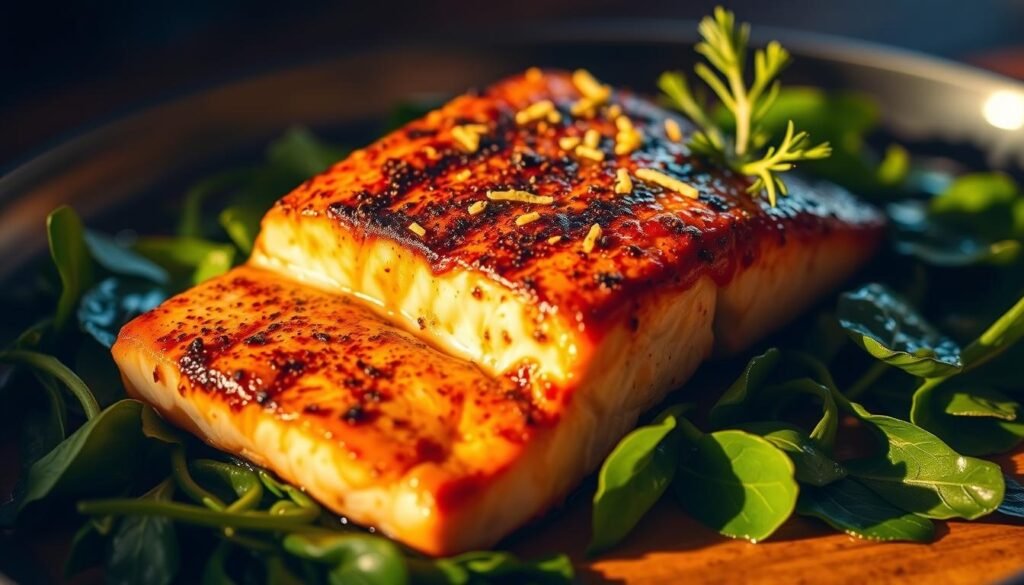
My kids devour this recipe—crispy edges, smoky spices, and zero complaints. Perfect for tacos or salads, it transforms leftovers into next-day lunches. Plus, it’s naturally gluten-free and paleo-friendly.
Chefs love its versatility. A hot skillet creates that signature crust, while the rich omega-3s stay intact. Whether you’re meal-prepping or hosting friends, this blackened salmon adapts effortlessly.
Is Blackened Salmon Healthy? The Nutritional Breakdown
Looking for a protein-rich meal that doesn’t skimp on taste? This Cajun-style favorite packs a punch with 29g of protein per serving—just 291 calories. Let’s dive into what makes it a standout choice.
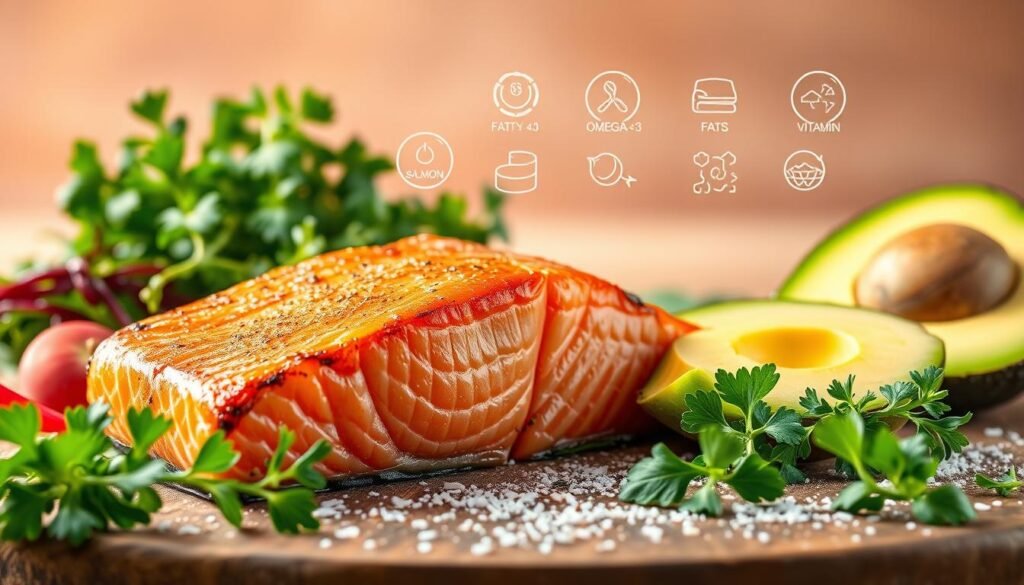
Rich in Omega-3s and Protein
The star here? Omega-3 fatty acids. Each serving delivers 4g of polyunsaturated fats, crucial for heart and brain health. Paired with 16g of total fat, it’s a balanced option for sustained energy.
Low in Calories, High in Flavor
A spice rub adds smoky depth without extra calories. Compared to fried fish, blackening keeps the dish light. Check out how it stacks up:
| Nutrient | Blackened Salmon | Fried Cod |
|---|---|---|
| Calories | 291 | 350 |
| Protein | 29g | 22g |
| Fat | 16g | 20g |
Essential Vitamins and Minerals
With 803mg potassium and vitamins A (587IU) and C (20mg) from lime, it supports immunity and heart health. A sprinkle of paprika boosts iron, too.
Key Ingredients for Perfect Blackened Salmon
The secret to bold, crispy salmon lies in two key elements: high-quality salmon fillets and a well-balanced spice blend. Skip the guesswork with these pro picks.
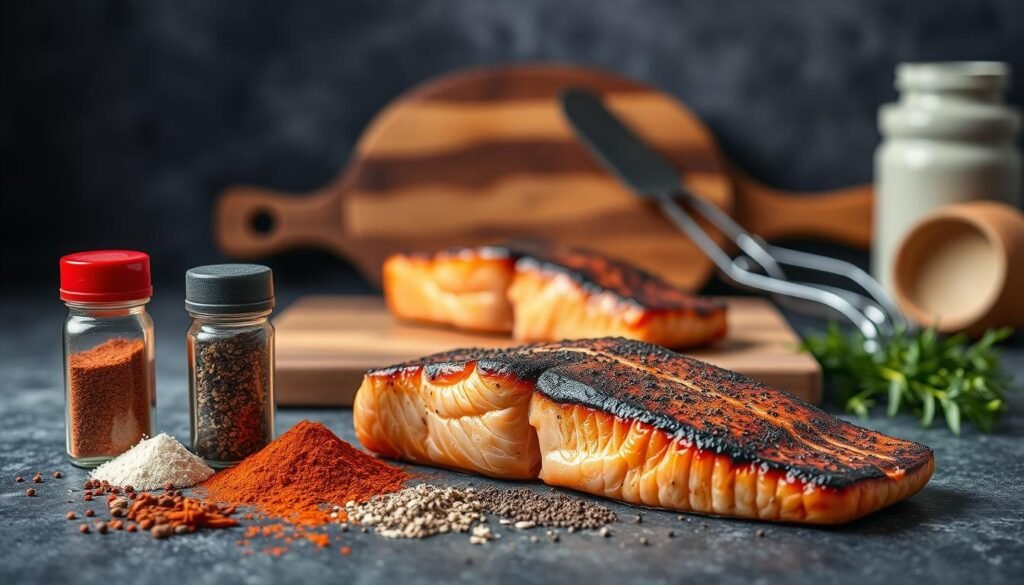
Choosing the Right Salmon Fillets
Wild-caught varieties pack more omega-3s and fewer contaminants than farmed. For the best texture:
- Skin-on fillets hold moisture during high-heat cooking.
- Pat dry with paper towels for maximum crispiness.
- Opt for center-cut pieces—they cook evenly.
The Magic of Blackening Spices
A homemade rub beats store-bought mixes. Combine these ingredients for depth:
- Smoked paprika (not regular) for a charred aroma.
- Garlic powder and onion powder for savory notes.
- Fresh lime juice—bottled lacks brightness.
Use avocado or refined olive oil—their high smoke point prevents burning. A hot cast-iron skillet seals in flavors without overcooking.
Step-by-Step Blackened Salmon Recipe
Ready to master a restaurant-quality dish at home? This recipe delivers crispy, spice-crusted fillets in under 30 minutes. Follow these pro techniques for foolproof results.

Preparing the Spice Rub
Whisk together in a small bowl:
- 1 teaspoon smoked paprika (for depth)
- ½ teaspoon garlic powder and onion powder
- ¼ teaspoon cayenne (adjust for heat preference)
- Pinch of brown sugar to balance flavors
Tip: Double the batch—it stores well for future meals!
How to Cook Salmon to Flaky Perfection
1. Pat dry salmon fillets with paper towels. Moisture prevents blackening.
2. Coat flesh sides evenly with the rub.
3. Heat a pan (cast-iron preferred) over medium-high until smoking.
4. Sear 2 minutes per side, then transfer to a 400°F oven for 8–10 minutes.
“The fillets should release easily when properly seared—if they stick, wait another 30 seconds.”
Oven vs. Stovetop Methods
Oven Finish: Best for even cooking. Internal temp should hit 145°F.
Stovetop-Only: Extend cook time by 3–4 minutes per side on lower heat.
Pair with low-carb sides or explore cast-iron skillet tips for crispier results.
Blackened Salmon Seasoning: Homemade vs. Store-Bought
A great dish starts with the perfect mix of flavors—homemade or store-bought? The right seasoning transforms ordinary fillets into a bold, smoky masterpiece. Let’s explore both options.
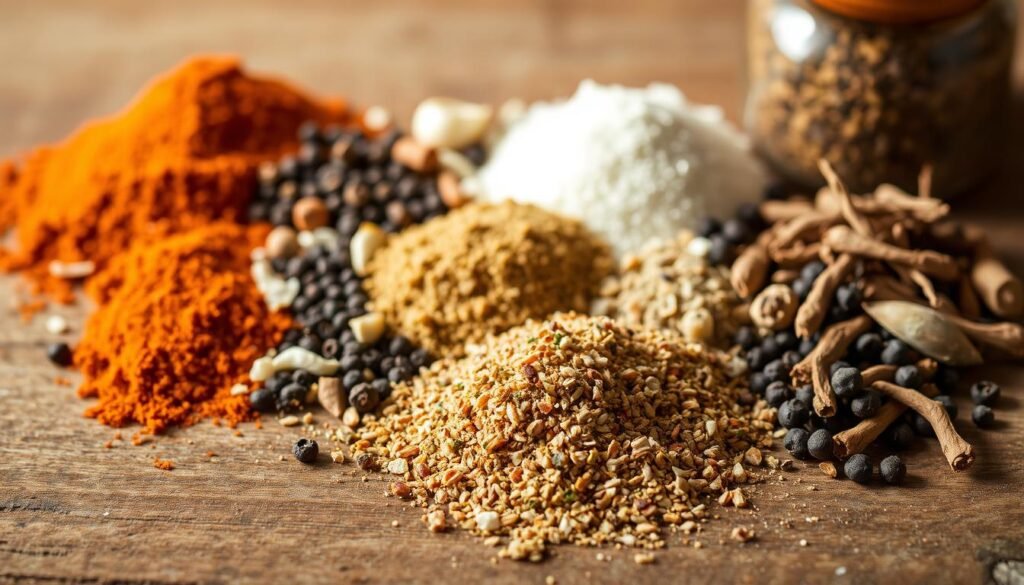
Crafting Your DIY Spice Blend
Homemade rubs offer full control over ingredients and heat. Whisk together:
- 2 tbsp smoked paprika (spice base)
- 1 tbsp garlic powder + 1 tsp onion powder
- ¼–1 tsp cayenne (adjust to taste)
- ½ tsp brown sugar (balances heat)
Pro tip: Triple the recipe and store in an airtight jar for 3 months. No preservatives needed!
Top Pre-Made Picks
Short on time? These blends deliver quality:
- Paul Prudhomme’s: Authentic Cajun kick (watch sodium—1,150mg per tbsp).
- McCormick’s: Milder flavor, lower salt (790mg per tbsp).
“Homemade costs $0.50/oz vs. $2.10/oz for premium brands—but convenience has value.”
Skip blends with MSG or fillers. Always check labels for hidden sugars.
Tips for the Crispiest, Most Flavorful Salmon
Want restaurant-quality results at home? These pro techniques guarantee crispy perfection. From temperature control to pan selection, small details make a big difference.
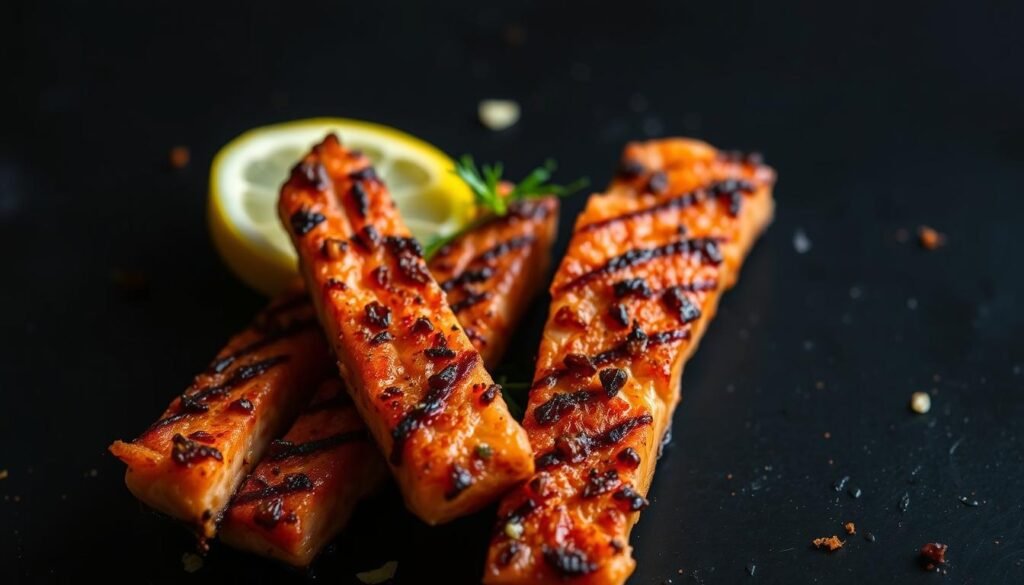
Keep the Fish Cold Before Cooking
Refrigerate fillets for 15–30 minutes before seasoning. Cold salmon sears better and stays moist. Pat dry with paper towels—any moisture steams instead of blackens.
Use a Hot Pan for Perfect Blackening
High heat creates a crust quickly. A cast-iron pan retains heat evenly. Preheat until smoking lightly, then add oil (avocado works best).
“If your fillet sticks, don’t force it—wait 30 seconds. A proper sear releases naturally.”
Don’t Overcrowd the Skillet
Cook in batches if needed. Crowding lowers the pan’s temperature, causing steam. For more tips, check this cast-iron guide.
- Pro tip: Use a thermometer—145°F internally ensures flaky doneness.
- No cast iron? Stainless steel works but heats less evenly.
What to Serve with Blackened Salmon
Pairing bold flavors with the right side dishes turns a good meal into a memorable one. Whether you prefer light, fresh options or hearty complements, these pairings balance texture and taste.

Light and Fresh Side Dishes
A citrus avocado salad cuts through the spice with creamy, tangy notes. Toss arugula, grapefruit segments, and diced avocado with lime vinaigrette. For crunch, add toasted almonds.
Garlic-roasted vegetables like asparagus or zucchini cook in 15 minutes—perfect for synchronizing with the salmon’s timing. Drizzle with olive oil and a pinch of salt before roasting at 400°F.
Hearty Pairings for a Complete Meal
Choose between cauliflower rice (low-carb) and jasmine rice (fluffy texture). Compare nutrition per cup:
| Nutrient | Cauliflower Rice | Jasmine Rice |
|---|---|---|
| Calories | 25 | 205 |
| Carbs | 5g | 45g |
| Fiber | 3g | 0.6g |
For drinks, try Sauvignon Blanc (crisp acidity) or Pinot Noir (earthy depth). Leftovers? Flake the fish into next-day grain bowls or tacos.
“A chilled white wine highlights the dish’s smoky spices without overpowering it.”
Explore more recipes like cilantro-lime quinoa or roasted sweet potatoes to round out your plate.
Creative Ways to Use Leftover Blackened Salmon
Got extra cooked fillets? Transform them into exciting new meals. Leftovers shine in tacos, grain bowls, or even breakfast scrambles. No reheating required—just creativity!
Salmon Tacos or Fresh Salads
Flake the fish into warm corn tortillas with lime crema and pickled onions. For a lighter option, toss it with a citrus-avocado *salad*. Pair with these dressings:
- Chipotle mayo: Smoky heat balances the fish’s richness.
- Mango vinaigrette: Sweet-tangy contrast for greens.
| Pairing | Prep Time | Best For |
|---|---|---|
| Tacos | 10 mins | Quick lunches |
| Salad | 15 mins | Meal-prep bowls |
Pasta and Grain Bowl Add-Ins
Elevate any *dish* by mixing flaked fillets into lemon-garlic pasta or quinoa. Try these combos:
- Breakfast hash: Sauté with sweet potatoes and eggs.
- Sushi rolls: Swap raw fish for blackened flakes.
“Quesadillas love Monterey Jack—its meltiness clings to every flake.”
Freeze extras in airtight packs for up to 3 months. Thaw overnight for omelets or fried rice. Explore more *recipes* to minimize waste and maximize flavor.
Healthier Swaps and Variations
Customize your dish for dietary needs without losing flavor. Small tweaks can make this recipe fit low-sodium, soy-free, or even vegan diets. Let’s explore smart adjustments.
Reducing Sodium or Spice Levels
Love the bold taste but need less heat or salt? Try these swaps:
- Low-sodium tamari: Use 1:1 instead of soy sauce (30% less salt).
- Coconut aminos: A soy-free alternative with a mild sweetness.
- Halve the cayenne pepper or use smoked paprika for depth without burn.
For poultry adaptations, skip the seafood rub. Use a blend of thyme, garlic powder, and a pinch of chili.
Alternative Fish Options
Not a fan of salmon? Other fish works beautifully:
- Mahi-mahi: Firmer texture, holds blackening spices well.
- Cod: Delicate flakes—cook 2 minutes less to avoid dryness.
“Vegan ‘salmon’? Roast carrots with nori flakes—surprisingly similar umami richness!”
Experiment with simpler ingredients to adapt classic salmon recipes. The goal? Keep it flavorful, no matter the diet.
Common Mistakes to Avoid When Cooking Blackened Salmon
Even seasoned cooks make these mistakes—here’s how to dodge them. A perfect sear and juicy interior hinge on timing, heat control, and smart prep. Let’s troubleshoot the top pitfalls.
Overcooking the Fish
Carryover cooking means fillets continue heating off the stove. Pull them at 140°F; they’ll hit 145°F while resting. Dry fish? A meat thermometer is your best friend.
Pro tip: For thicker cuts, reduce heat after searing. Finish in a 400°F oven for even doneness.
Skipping the Butter or Oil
Oil creates that crispy crust. Brush fillets lightly—don’t drown them. Avocado or refined olive oil handles high temps without burning.
Watch out: Basting with butter adds flavor but burns faster. Use clarified butter for higher smoke points.
- Smoke alarm alert: Blackening spices can trigger alarms. Open windows or use the stove vent.
- Spice errors: Measure rubs precisely. Too much cayenne overpowers; too little lacks depth.
- Check expiration dates—stale paprika tastes musty, not smoky.
“A cold pan causes sticking. Wait until it’s shimmering-hot for that perfect release.”
Conclusion: A Healthy, Flavor-Packed Dinner Choice
From skillet to table in 30 minutes—flavor and nutrients intact. This omega-3-rich salmon delivers a protein boost while keeping weeknights effortless.
Play with the spice blend to match your heat preference. Smoked paprika or cayenne? Your call. Nutrient-dense and versatile, it’s a dish even picky eaters devour.
Ready to make it? Share your twist on this recipe—bold flavors deserve a spotlight. Dinner just got smarter.




